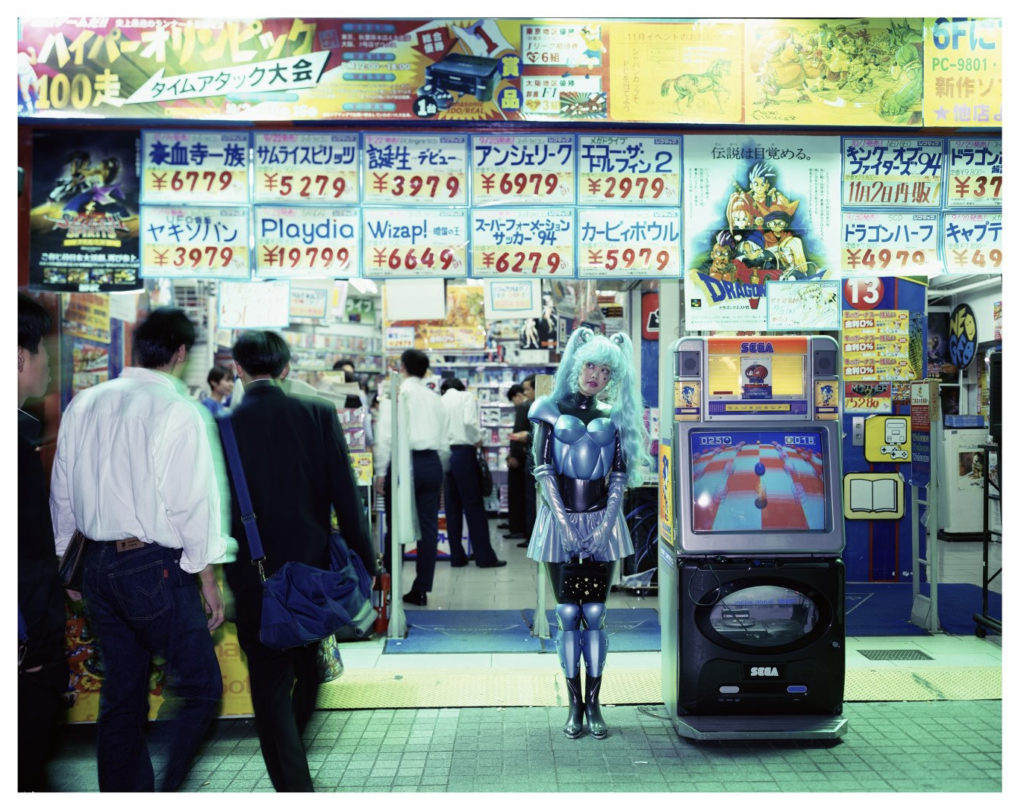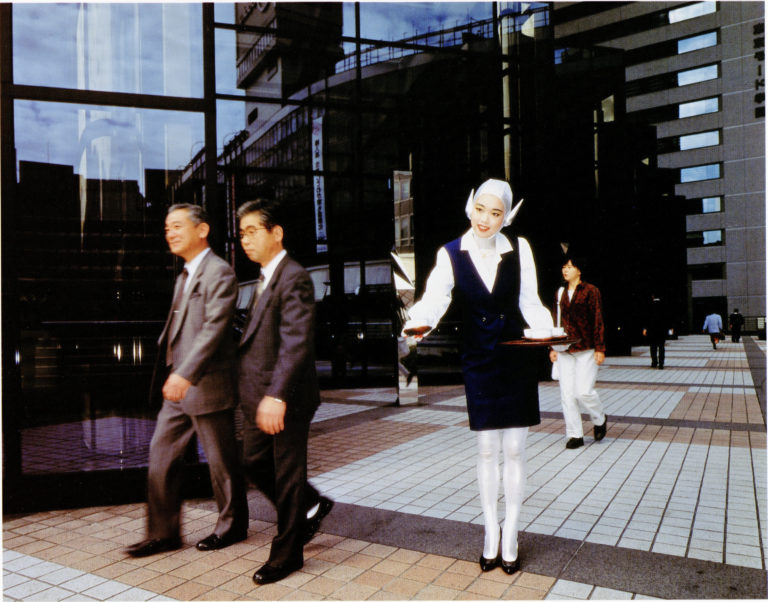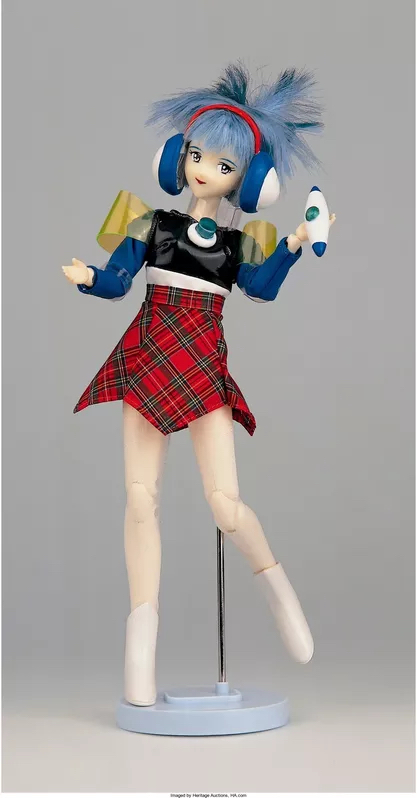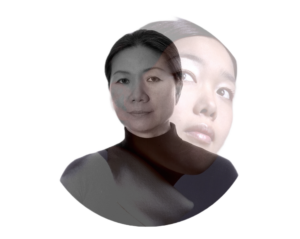Feminism in Contemporary Japan
This chapter focuses on the early phase of Mori’s career when she revealed strong concern with the exploitation of women’s labor and body, and how she begins to explore this concern in many of her works. To understand Mori’s representation of women’s bodily resistance to societal norms, it impertinent to look at the history and issues of gender equality and feminism in contemporary Japan. There are numerous ways to approach the topic of feminism in Japan during Mori’s time. First, and perhaps most closely linked to Mori, was the women’s liberation movement called uman ribu, or ribu, also known as Japan’s second wave of feminism. This movement emerged in postwar Japan in the economic boom of the 1960s and early 1970s.[16] The rapid and high economic growth in the 1960s further reinforced the division of labor by gender.[17] This women’s liberation movement was often the butt of ridicule by critics and newspapers run by men but nonetheless got attention in mass media. A headline in Asahi newspaper in 1970 described the women of this movement as “brave micro-mini-skirted beauties.”[18] As we will see in Mariko Mori’s early works, it appears that she capitalized on this headline.[19] In the late 1960s, many ribu activist groups were founded by young, middle-class, university-educated women. It would not be unsurprising that Mori was influenced by these groups, especially being a teenager at the time, going to fashion school in an urban area. As described in the following paragraph, Mariko Mori’s work from 1994 addresses this wave of feminism because it represented the time for women in Japan when they were radically requisitioning oppression and gender roles of modern Japan.[20] This was a time of great sexual liberation. A famous ribu manifesto written by Tanaka Mitsu in 1970 titled “Liberation from the toilet,” accused “Japanese culture and society of promoting the sexual objectification of women and patriarchal power over female sexuality” in terms that were belittling, such as “good wife” or “whore.”[21] This manifesto and the movement at large fought for a more holistic female sexuality, taking back the agency of their own bodies.[22] Later on we will see how the Esoteric Cosmos with its Buddhist cycle of birth, death, and rebirth, can be connected to uman ribu and the importance of physicality and motherhood.
The second way to approach feminism and gender issues in Japan is by considering the oppression of women in the workplace. Specifically, Jonathan Wallis describes this as the “paradoxical liberation and oppression of Japanese women in the corporate workplace, the infantilization of Japanese women in both the real and virtual worlds and the exploitation of the entertainment industry in sexualizing and complicating the relationship of woman as an image in mass culture within urban Japan.”[23] This oppression, exploitation, and complication of women at the time in Japan can be linked to the complex cultural climate of Japan in the mid-90s. The reliance on American support following World War II resulted in a shift in cultural values. American ways of life were adopted, especially a fixation on popular culture. The surge in corporate culture and mass consumerism affected traditional gender roles. However, in 1995, the financial bubble burst in Japan, bringing general anxiety to the country and complicating the treatment and position of women even further. Recession, political instability, and corruption were among some of the post-bubble Japan issues. Mori studied in London and New York during the apex of the bubble economy in Japan, but her return was in this deflated period that saw an endless cycle of consumption, desire, and waste that she capitalized on. At first glance, Mori’s photographs may look like Japanese culture is thriving and Tokyo is a megacity. However, the harsher realities of post-bubble Japan can be found under the surface of sexy cyborgs in front of toy stores and alien women serving tea. Mori’s superficial characters that appear to be enjoying the pleasures of life and ease of living are but a veil over the deeper critical commentary on a consumption-obsessed society.[24]
Feminist art of the 70s and 80s was concerned with deconstructing patriarchal control and celebrating female and sexual liberation.[25] Mori doesn’t celebrate the natural body. Instead, she exploits her beauty and her sexuality. Mori underlines the synthetic rather than the natural, that the first wave of feminists emphasized. Celebrating feminine beauty without oppressive conformity is evident in Mori’s work. However, Wallis argued that describing an artist as a “feminist” just because they present the female body is “dangerously misrepresentative and potentially offensive.” Mori believed that there are different roles for women and men based on native people and cultures, unlike the early waves of feminism that promoted women standing against and being more powerful than men. Nonetheless, Mori disagrees with the systems in Japan that have always restricted women’s opportunities to lower grade tasks or expectations to leave employment after childbirth or childbearing and staying home to run the family.[26]
Indeed, the Japanese perspective towards gender was at odds with Western understanding of feminism. The creators of third wave feminism mainly published in Western languages and were criticized for “the apparent academicism aloof from the social political reality of non-Western countries.”[27] Born in a non-Western country but receiving an education primarily from the West, Mori saw and experienced the waves of feminism from both perspectives. She understands that the notion of a united sisterhood called “woman,” as scholar Jieun Rhee explains, is an illusion.There is no one womanhood that defines us all or looks the same for everyone. Rhee discusses Donna Haraway and her Cyborg Manifesto in relation to the cyborg. Donna Haraway describes the myth of “us” and binding all females together under one umbrella. Mori confronts the fiction of Asian women conjured by Westerners as the sexually charged goddess or geisha and simultaneously as the submissive but threatening cyborg.[28] Mori uses this illusion to her advantage and, as mentioned previously, highlights the synthetic rather than the natural that the first wave of feminists emphasized. Rhee also describes the process of Mori’s own goddess being hybridized, digitized, and synthesized, and becoming “a cyborg that transgresses the boundaries of East/West, male/female and past/future.”[29] Haraway noted that the “women of color’ might be interpreted as a cyborg “from fusions of outsider identities” and “complex political-historical layerings.”[30] However, there are certainly critiques of Haraway’s analysis and how it pertains to issues of ethnicity and race. The lens in which this thesis uses Haraway is through the myth of “us” and the creation of the cyborg. The creation and repetition of the cyborg in Mori’s work, along with countless other extraterrestrial elements, can be interpreted as this feeling of being the outsider or even the need to transgress boundaries.
Understanding Differences: Pre-Cosmos
As stated previously, Mori accepts and understands the designated roles for women and genders in Japan, however, this would be hard to grasp for feminists in the West. Mori’s acceptances of these designated roles for women is the cultural difference that Mori explains and explores in her own work. Rather than the revolt and aggression associated with Western feminism, Mori approached empowerment in art via passivity and acceptance, explaining that she likes a balance in her art: femininity that is soft and strong at the same time. Feminist politics and feminist ideas have a unique relationship to “femininity” as both a set of visual associations and cultural ideas. The femininity that Mori incorporates into her work doesn’t have to exist with feminist politics and vice versa. However, in this situation, it is a mutual existence because we know that Mori is associated with feminist ideas, just not as harshly as some forms of Western feminism. In examples of her work throughout this chapter, we will see that there is power in being soft and listening, and sometimes the message comes across even stronger than being aggressive.[31] Mori’s images during the mid-1990s represent a hodgepodge of feminist viewpoints. Her cleverness and “softness” might be interpreted by western feminists as being submissive, but that reveals an even deeper side of “female oppression and exploitation in post-bubble Japan” beyond just externalized anger.[32] Just before Mori went to London, a wave of Japanese feminist movements made a cultural impact. The “Super Girls of art” celebrated young female artists in Japan in the mid-1980s to early 90s, paving the way for new female artists and new role models. However, the way these artists were discussed by critics focused on their gender. The tendency to categorize woman artists as “female artists” was restrictive in the “Super Girls of art” movement. It created a generalized “feminine” style and reinforced the gender stereotypes of how women (and men) express themselves via art.[33] The cultural impact of these feminist movements would have been known to Mori and would explain her creation of future projects.
In 1994, Mori created Play with Me (Fig. 3), which depicts the artist as an idoru, or self-constructed idol, commonly seen in the world of anime, J-pop, and digital gaming. According to Allison Holland, these idols reflect the movement of cosplay (costume playing) that has been popular with Japanese urban youth since the 1990s. [34] Standing in front of an electronic store in Tokyo, Mori has blue hair and is armored in a “futuristic

Figure 3. Mariko Mori, Play with Me 1994. Courtesy of Deitch Projects Fuji Super Gloss print, wood, pewter frame 120.1 x 144.1 x 3 inches
survival suit.”[35] At this time in Mori’s career, she began to articulate her interest in role-playing, consumerism, and its exploitation of the female body in the Japanese society. This is evident in the hypersexualized cyborg featured in Play with Me, as she goes completely unnoticed in front of a storefront among dozens of advertisements. Although she is armored and front-facing, the “idol” or idoru that Mori creates in Play with Me, and similar idol characters that continue to appear at this stage in her career lack agency. Scholar Allison Holland describes these idols are like gaming avatars or anime characters that appear “to be controlled by an unseen game player,”.[36] In many of Mori’s works around this time and when she returns to Tokyo, she created a female protagonist, usually the artist in costume, that engages in a “stereotyped ‘female’ role filtered through recent technological, economic, or cultural change,” such as female tropes and roles that were popularized in mass media.[37] These include office lady, fashion model, prostitute, urban wannabe, and wife. [38] Either performing in costume or inserting a transformed self-portrait into a Tokyo scene, Mori’s women are both connected and disconnected from their surroundings at the same time. Dressed up as an expectant anime prostitute in front of an electronic store, Mori is both standing out from her environment but also playing into it, as she performs a familiar task or dutiful task often assigned to certain women in Japan.[39] Mori’s Play with Me character stands submissively waiting for a man, with her girly hairstyle, head tilt, and wanting eyes. The men in the image walk past her at a distance and don’t appear to see her at all. They’re dressed in simple business clothes, in high contrast to Mori’s cyborg outfit. Mori’s feminism and the women’s liberation movement in Japan in the 60s and 70s attacked the existing view in Japanese society that women must fulfill certain defined social roles.
With her debut and groundbreaking exhibition “Made in Japan” in 1995, featuring herself as a sex robot (Fig. 4), Mori used art to make a feminist statement.[40] The doll version of Mori as a sex robot is called the Star Doll (Fig. 5) and was made as a limited edition set of 99. The doll resembles Mori’s real-life version in Figure 4, with the same clothing, blue hair, and robotic attributes. In another series, Tea Ceremony, from 1995, the statuses and roles of women in late-twentieth-century Japanese society were the main focus. As a cultural ritual in Japan, the tea ceremony is incorporated into the practice of Japanese Zen Buddhism and serves to cleanse or purify the spirit.[41] Tea ceremonies in Japan have been represented in art for centuries. However, Mori’s interpretation makes a mockery out of the Japanese convention of female employees in charge of serving tea. The convention is tied to the female identity that the Japanese patriarchy framed for women, expecting women to serve men. In 1998, Mori acknowledged that she left Japan to get the freedom to do what she wanted to achieve in her life. She stated that “the position of women in Japan wasn’t accommodating her desire or ambition,” and when she returned to Tokyo in 1994, these images were her protest against Japanese society.[42] It was a very personal reaction from Mori and a straightforward representation of the gender issues in Japan at the time. Tea Ceremony III (Fig. 6) depicts Mori as an imaginary anime character doing the most common task of Japanese women, serving tea. This represents men’s expectation for women in the daily life. This goes back to women traditionally keeping the household and being the caregivers for the family, however, Mori combats this with the use of the corporate setting. The staging in a sterile office and the fact that a woman is in this setting at all makes Mori’s character that much more shocking. As men sit around a conference table or walk right past Mori on the street in this series, it is clear that she isn’t being seen. You can go a step further and say she is being ignored by the men she’s serving and the people on the streets of Tokyo. Even the alien-like head piece and metallic leggings indicate that a woman is out of place in this setting; So much so that she is from another planet. The position of women serving men in Japan wasn’t accommodating her desire or ambition.
In Tea Ceremony III, another piece in this series, Mori takes the traditional tea ceremony into the public streets of Tokyo, asking the public to engage with the issue. This was Mori’s form of protest. In contemporary Japanese art, issues of gender are still prominent, and the many artworks that address the subject indicate not only that gender issues are related to political and social factors in contemporary Japanese society, but also that these contemporary Japanese female artists are “aware of these relationships and engage in addressing the issues by means of their art.”[43] Tea Ceremony III can be read as a protest of protests the limited opportunities for women and the tendency of Japanese society to be so fastened to tradition. Mori establishes that identity and the role of the Japanese woman isn’t just a feminist issue. It’s a societal one.



